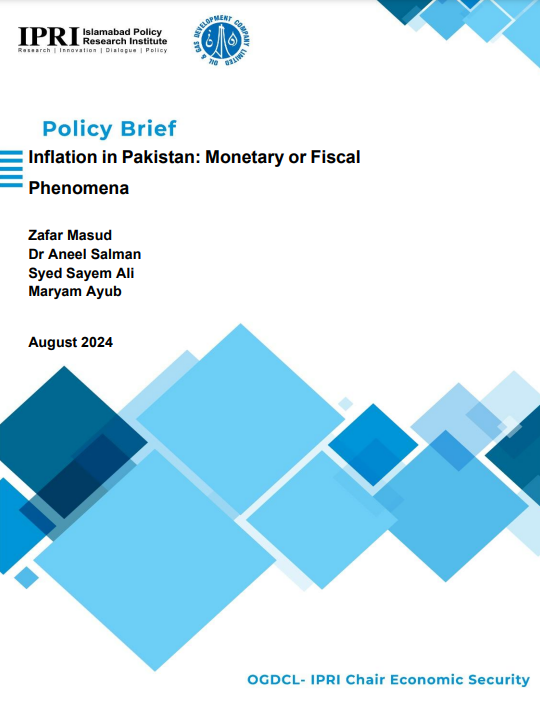Previous: Inflation in Pakistan: Monetary or Fiscal Phenomena — IPRI Policy Brief Pt. 1
Is CPI Truly Reflecting the Economic Reality of Pakistan?
High and persistent inflation rates have been a concern for Pakistan. Inflation can be effectively controlled if the instrument for measuring inflation is accurate and reflects the consumer preferences for goods and services. Following is an analysis of how inflation is measured and the possible issues in measuring inflation that can be addressed.
In Pakistan, 3 indices are used for calculating inflation namely, wholesale price index (WPI), Sensitive Price index (SPI) and Consumer Price Index (CPI). However, CPI is the main instrument to measure inflation in Pakistan, as in many other countries. It measures the changes in the overall cost of buying a fixed basket of goods and services and generally represents the country’s inflation rate.
Currently, the Pakistan Statistical Bureau (PBS) has been publishing 5 indices on a monthly/weekly basis: National Consumer Price Index (NCPI), Urban Consumer Price Index (UCPI), Rural Consumer Price Index (RCPI), Wholesales Consumer price index (WPI) and Sensitive Consumer Price Index. A total of 487 items of goods and services divided into 12 major commodity groups are covered in the CPI.
In the new base year 2015-16, the weighted average of Urban CPI and Rural CPI for 12 commodity groups is used to calculate the National CPI. Urban CPI includes 356 consumer items and 35 cities. Whereas, Rural CPI includes 244 consumer items and 27 rural centres. For each item, 4 price quotations are obtained from different shops in the markets. The markets are selected based on sales volumes, assuming the maximum consumers purchase goods from them.
In 2014, the PBS governing council announced to rebase the National Accounts and Price Statistics every 10 years with 2015-16 serving as the current base year1. One of the issues with Pakistan’s CPI is its base year. Recently, Pakistan has witnessed a sharp decline in the CPI Inflation rate to 11.8% in May 2024 from 37.97% in May 2023. This decrease in the inflation rate has not lessened the burden for the common people as in reality prices of consumer goods and services have not reduced as this decline is attributed to the High base year effect
The weights of items in the consumer basket are derived and revised from the Family Budget Survey. PBS has conducted a Household Integrated Economic Survey (HIES) during the years 2004-05, 2007-08, 2010-11, 2013-14, and 2015-16, and the latest survey was conducted in 2018-19. However, to rebase price indices and compute the separate weights of all items, a special survey namely, the Household Integrated Income and Consumption Survey (HIICS) was conducted in 2015-16.
Obtaining a price census for every consumer transaction in the country is not attainable, hence the composition of a basket of goods. However, the basket should be consistent with people’s changing consumption and expenditure patterns. Currently, Pakistan’s CPI basket accounts for a small number of goods and services.
Another, major issue with the current composition of the CPI basket is that it may not accurately reflect societal consumption trends or their future trajectory. Several items in the RCPI and UCPI list are irrelevant and need to be excluded, while new items that should be included in the consumer basket are overlooked. In the UK, items in the consumer basket of CPI are reviewed at the start of the year, irrelevant items are excluded and new items introduced in the markets are added to the consumer basket. Such statistical updates are important because they take into account the changes in expenditure patterns of the consumers.
| Countries | No. of Items | Base Year Revision | Weights Revisions |
|---|---|---|---|
| China | 500 | 5 years | 5 years |
| Malaysia | 552 | Last updated as 2010 | 2 years |
| Japan | 582 | 5 years | 5 years |
| United Kingdom | 744 | 5 years | 5 years |
| Vietnam | 756 | 5 years | 5 years |
| Mauritius | 194 | 5 years | 5 years |
| India | 448 (Rural CPI) 460 (Urban CPI) 465 (CPI IW) 85-106 (CPI AL) | 10 years | 5 years |
| Bangladesh | 469 (Urban CPI) 341 (Rural CPI) | 10 years | 10 years |
The price data for Urban CPI is currently collected from 68 markets across 35 cities. Each city selects the number of markets, from 1 to 13, for price collection. Currently, the chosen marketplaces in Pakistan’s major metropolitan cities are as follows: Karachi (11), Lahore (7), Faisalabad (2), Rawalpindi (5), Gujranwala (1), Peshawar (3), Multan (3) and Hyderabad (4). The representation of these majorly populated cities is quite low. Lahore, being the 2nd most populous city, deserves better representation in CPI data as price collection is done from only 7 selected markets. The price collection is done from only 7 markets. In 2022, the rural population counted for 62%2 , however, price collection is done from 27 rural centres only.
Up Next: Overview of Inflation Dynamics of Pakistan — IPRI Policy Brief Pt 3
Inflation in Pakistan: Monetary or Fiscal Phenomena
IPRI — Islamabad Policy Research Institute
Policy Brief by
- Zafar Masud
- Dr. Aneel Salman
- Syed Sayam Ali
- Maryam Ayub
August 2024
OGDCL – IPRI Chair Economic Security
